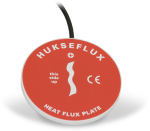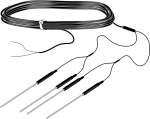
Self-calibrating; ideal for energy-balance in eddy-covariance and Bowen-ratio systems






Resumen
El HFP01SC mide el flujo de calor en el suelo con autocalibración, y es utilizado típicamente en sistemas de medida del balance de energíaty y en sistemas Bowen-ratio. Está pensado para aplicaciones que requieran un alto grado de precisión en la medida del flujo de calor. Para disponer de un valor promediado espacial es habitual hacerlo con dos sensores. Si el medio es heterogeneo puede ser necesario utilizar sensores adicionales.
Leer másVentajas y características
- Corrige errores debidos a diferencias en la conductividad térmica entre el sensor y el medio, variaciones de temperatura y inestabilidades leves del sensor
- Compatible con la mayoría de nuestros dataloggers
- Usa el método de auto calibración de Van den Bos-Hoeksma para proporcionar un alto grado de precisión en la medida
Imágenes



Descripción detallada
The HFP01SC consists of a thermopile and a film heater. The thermopile measures temperature gradients across the plate. During the in-situ field calibration, the film heater is used to generate a heat flux through the plate. The amount of power used to generate the calibration heat flux is measured by the datalogger. Each plate is individually calibrated, at the factory, to output flux.
Self-calibration corrects for errors due to differences in thermal conductivity between the sensor and surrounding medium, temperature variations, and slight sensor instabilities.
Productos similares
Preguntas frecuentes
Número de FAQs relacionadas con HFP01SC-L: 9
Expandir todoDesplegar todo
-
Rather than using a running average to find the millivolt output during a calibration, use a single sample with 50 or 60 Hz integration. See Example 1 in the 2014 or later version of the HFP01SC-L manual.
-
Can the HFP01SC-L be embedded in railroad ballast, which comprises a blend of coarse rock particles?
No. The HFP01SC-L must be in full contact with the media. Railroad ballast is too coarse.
-
The example CRBasic program runs in either SequentialMode or PipeLineMode. To force the CRBasic program to run in PipeLineMode, add the instruction PipeLineMode to the beginning of the program.
-
A calibration shift occurs if the HFP01SC-L is not making full contact with the soil during the calibration cycle. The following could cause the plate to lose contact with the soil: a soil freeze/thaw cycle, soil swelling/contracting because of extreme drying/wetting cycles, or rodents burrowing past the plate.
-
The in-situ calibration is helpful for quality assurance/quality control. The multiplier determined from the in-situ calibration should be within ±10% of the factory-determined calibration. If it is not, the plate may be damaged, not wired correctly to the datalogger, or not making full contact with the soil.
-
Because of the loss of IR radiation, nearly all thermopile instruments typically have a negative offset. This offset is most easily visible at night-time, when a small negative value is read instead of zero. This same offset is present during the daytime, but it is not as visible because of the large solar signal.
Another common issue involves leveling an instrument. Leveling a thermopile instrument can cause errors in the direct beam component because the cosine response is not correct. These errors are more notable when the sun is close to the horizon because the angle is so shallow.
-
The information included on a calibration sheet differs with each sensor. For some sensors, the sheet contains coefficients necessary to program a datalogger. For other sensors, the calibration sheet is a pass/fail report.
-
Add the appropriate code to the datalogger program using a program example from the HFP01SC-L manual. Alternatively, contact Campbell Scientific for assistance.
Compatibilidad
Nota: lo siguiente muestra información de compatibilidad notable. No es una lista de todos los productos compatibles.
Dataloggers
| Producto | Compatible | Nota |
|---|---|---|
| CR1000 (retired) | ||
| CR300 (retired) | ||
| CR3000 (retired) | ||
| CR310 | ||
| CR350 | ||
| CR6 | ||
| CR800 (retired) | ||
| CR850 (retired) |
Información de compatibilidad adicional
Datalogger Considerations
An external relay (e.g., A21REL-12) that supplies 12 Vdc to the heater is required when this probe is used with a 21X, CR10 with the silver wiring panel, CR7, or CR9000.
Especificaciones
| Sensor Type | Thermopile with film heater |
| Sensitivity | 50 μV W-1 m-2 (nominal) |
| Nominal Resistance | 2 Ω |
| Temperature Range | -30° to +70°C |
| Expected Typical Accuracy | ±3% of reading |
| Heater Resistance | 100 Ω (nominal) |
| Heater Voltage Input | 9 to 15 Vdc |
| Heater Voltage Output | 0 to 2 Vdc |
| Duration of Calibration | ±3 minutes @ 1.5 W (typically performed every 3 to 6 hours) |
| Average Power Consumption | 0.02 to 0.04 W |
| Plate Diameter | 80 mm (3.15 in.) |
| Plate Thickness | 5 mm (0.20 in.) |
| Weight | 200 g (7.05 oz) without cable |
Documentos
Casos de aplicación
Descargas
CR1000X HFP01SC Example program v.2 (3 kb) 18-02-2020
CR1000X program that measures the HFP01SC, performs the self-calibration, and checks for calibration validity. Refer to the manual for the equations used for the self-calibration and calibration-validity checks. A table in the manual provides a cross reference of the terms in the equations in the manual with the constants and variables in the example data logger program.
Casos de aplicación
Overview In the fight against climate change, innovative solutions are emerging to address the global challenge......leer más
This case study discusses the integration of CPEC310 and AP200 systems to explore the theories......leer más
Scientists and land-use managers have long recognized the importance of forest lands for their role......leer más
The Austin College Weather Station (ACWX) is located on Austin College's Sneed Environmental Research Area,......leer más





